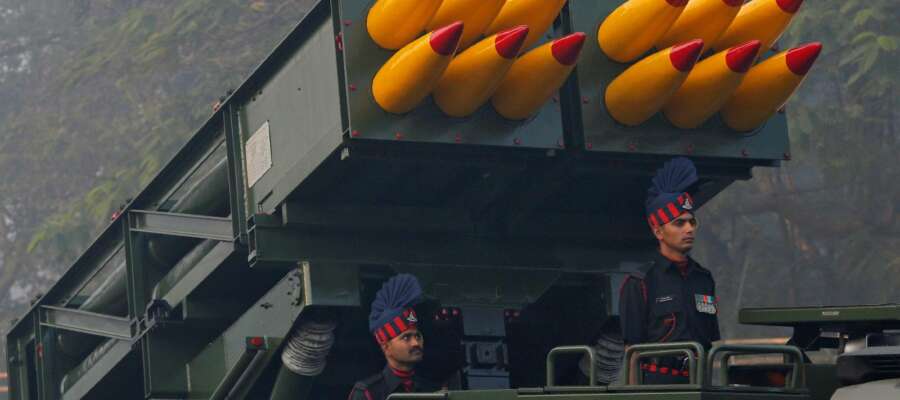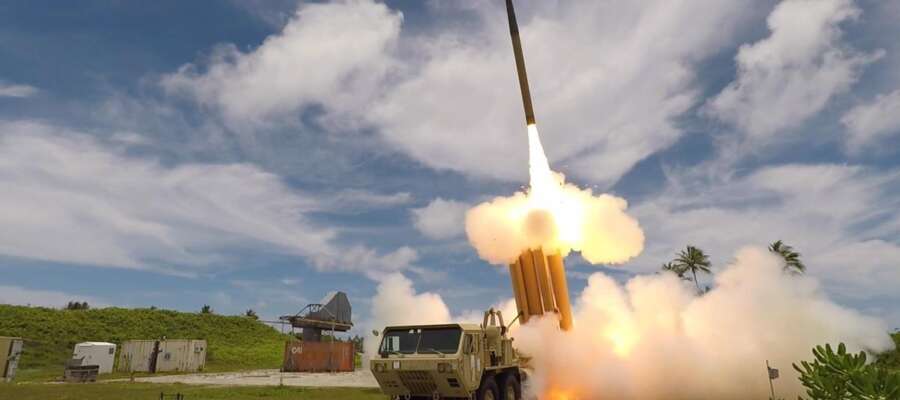ADVANTAGE INDIA

Growing Demand
Demand Growth is likely to accelerate with rising concerns of national security.
There is a critical need to build technological capabilities over neighboring countries.

Government Support
Introduced Green Channel Status Policy (GCS) to promote & encourage private sector investments in defense production to promote the role of private sector.
A total of 201 MOUs, Product Launches & Technology Transfers were concluded at Aero India 2021, by the Ministry of Defense.
Defense Production & Export Promotion Policy 2020 will provide much-needed push &impetus to attain self-reliance in defense manufacturing.

Competitive Advantage
Government of India changed the Automatic Route Limit for FDI in the Defense Sector to 74%. This is expected to boost national security, internal security, self-sufficiency in product design, increased investments, income & employment.
The Government announced the Defense Budget worth Rs 478,195.62 Crores (US$ 65.64) for 2021 – 22.

Opportunities
India’s proactive approach towards foreign mutual trade & rising joint agreements with foreign countries such as USE, Kazakhstan and the US for joint defense manufacturing and strengthening defense ties – offer huge potential & growth opportunities to boost defense manufacturing in India.

Introduction to Indian Defense Industry
The Indian defence industry is a significant sector for the economy.
The industry is likely to growaround rising concerns of national security. Demand for defence products, services, and equipment in India has been growing due to ongoing territorial disputes with neighbouring countries and escalating concerns on account of national & internal security.
Over last five years, India has been ranked among the top importers of defence equipment in order to gain technological & strategic advantages. To modernise its armed forces and reduce dependency over external dependence for defence procurements, several initiatives have been taken by the government to encourage ‘Make in India’ initiativesthru policy support by central government and its agencies.

Market Dynamics
India’s defence manufacturing sector has witnessed a CAGR of 3.9% in between 2016 and 2020. Government of India has set-up the defence production target at US$ 25.00 billion by 2025 (including US$ 5 billion from exports by 2025).
Defence exports from India was estimated to be at US$ 1.29 billion in 2019-20. India’s defence import value stood at US$ 463 million for FY2020 and is expected to be at US$ 469.5 million in FY21. Taking into account, such initiatives, defence exports in the country witnessed strong growth in the last two years.
India targets to export military hardware worth US$ 5 billion (Rs. 35,000 crore) in the next 5 years. As of 2019, India ranked 19th in the list of top defence exporters in the world by exporting defence products to nearly 42 countries.

A Brief on Recent development / Investments
Foreign Direct Investment (FDI) equity inflow in the defence sector for April 2000 – September 2020 stood at US$ 10.05 million (Rs. 60.77 crore) as per data released by the Department for Promotion of Industry and Internal Trade (DPIIT).
- In February 2021, Ministry of Defence (MoD) and Defence Public Sector Undertaking (DPSU) Bharat Electronics Limited (BEL) signed a contract for procurement of Software Defined Radio Tactical (SDR-Tac) worth Rs 1,000 crore (US$ 137.50 million).
- In February 2021, at Aero India 2021 in Bengaluru, Hindustan Aeronautics Limited (HAL) and Mishra Dhatu Nigam Limited (MIDHANI) signed a memorandum of understanding (MoU) for development and production of composite raw materials.
- In January 2021, the Institute of Nuclear Medicine and Allied Sciences (INMAS), a Delhi-based DRDO laboratory, presented Rakshita, a bike-based casualty transport emergency vehicle to Central Reserve Police Force (CRPF).
- In December 2020, the Indian Military acquired Sea Guardian drones from the US under the 2018 Communications Compatibility and Security Agreement, which facilitates secure exchange of military information and data between platforms operated by both countries. The partnership eases way by which India can buy unmanned aerial vehicles (UAVs) and promotes greater India-US cooperation on maritime domain awareness.
- In December 2020, The Economic Times reported that India is planning to develop an air-launched swarm drone system to overwhelm Chinese air defense, giving their fighter jets an edge in any potential conflict. The development process of the project is expected to take four years. State-owned aerospace and defense manufacturing company Hindustan Aeronautics Ltd. is partnering with two start-ups to work on the project, according to The Economic Times.
- In December 2020, India and Vietnam agreed to collaborate on numerous domains such as shipbuilding, surface and subsurface capacities such as submarines at sea. Both sides also signed the agreement on Hydrographic cooperation that will enable sharing Hydrographic data and assist in the production of navigational charts.
- In December 2020, The Economic Times reported that India is developing very high altitude and long endurance unmanned aircraft for surveillance and reconnaissance purposes. The vehicle is being designed to fly 70,000 feet for a period of days, providing real-time feedback to controllers while remaining beyond the range of most air defense systems.
- In December 2020, Advanced Towed Artillery Gun System (ATAGS) development reached the last stages of its trial and reportedly, could soon be inducted into the Indian Army. ATAGS is being developed by the Defence Research Development Organisation’s (DRDO) Armament Research Development Establishment (ARDE) Pune, Defence Electronics Application Laboratory, Dehradun, and the Centre for Artificial Intelligence and Robotics, Bengaluru, along with major corporates such as Bharat Forge, TATA Power SED, Ashok Leyland and Cummins.
- In November 2020, the fifth Scorpene submarine of Project-75 ‘Vagir’ was launched at Mazagon Dock Shipbuilders Limited (MDL) in Mumbai, positioning India as a submarine building country and contributing to the government’s ‘Make in India’ and ‘Aatmanirbhar Bharat’ initiatives.
- On October 29, 2020, the Indian Army developed a ‘Secure Internet Application (SAI)’, a simple and secure message framework, which supports stable end-to-end voice, text and video calling services on an android platform.
- On October 28, 2020, the Indian Army introduced the ‘Infrastructure Management System (IMS)’ software to empower defence stakeholders, make operations more efficient and transparent, and enhance accountability.
- On October 27, 2020, India and the US signed the ‘Basic Exchange and Cooperation Agreement for Geo-Spatial Cooperation (BECA)’ to strengthen defence ties between the two countries.

Government Initiatives
Government structured and circulated ‘Defence Production and Export Promotion Policy 2020’ to provide push to self-reliance in defence manufacturing under the ‘Aatmanirbhar Bharat’ scheme. The ministry aims to achieve a turnover of Rs. 1 lakh 75 thousand crore (US$ 25 billion), including an export of Rs. 35 thousand crore (US$ 5 billion) in the business space of aerospace and defence goods and services by 2025./p<>
To encourage more participation from start-ups and micro, small & medium enterprises (MSMEs) in Defence Research & Development (R&D) in achieving the ‘Atmanirbhar Bharat’ goal, the Defence Minister Mr. Rajnath Singh released a new version of ‘Defence Research and Development Organisation (DRDO) Procurement Manual 2020’ on October 20, 2020.
There are plans to establish new infrastructure including a defence park in Kerala to manufacture defence equipment for the armed forces. The project is aimed at promoting MSMEs and boosting the ‘Make in India’ initiative.
In November 2020, the Department of Defence, in partnership with the DGDE and Armed Forces, established a land management system (LMS) as part of efforts to enhance the overall defence land management.
In February 2021, Defence Research and Development Organisation (DRDO) handed over Licensing Agreements for ToT (LAToT) for 14 DRDO developed technologies to 20 industries at Aero India 2021 in Bengaluru.
To enhance defence manufacturing initiatives in India and make the country a reliable supplier to the world &friendly countries, the Indian government allowed the following FDI limits in September 2020.
For new licensees – FDI allowed up to 74% through automatic route; FDI beyond 74% would need to be permitted under the Govt. route. For existing Licensees – Infusion of new foreign investments up to 49% can be added by making declarations of change/transfer within 30 days.
Defence ministry plans to put 101 defence items (artillery guns and assault rifles) under import embargo to offer potential military hardware manufacturing opportunities to the Indian defence industry. In February 2020, Defence Minister, Mr Rajnath Singh at Aero India 2021 announced to reduce defence imports by at least US$ 2 billion by 2022.
As per estimation, the defence ministry envisages potential contracts worth ~Rs. 4 lakh crore (US$ 57.2 billion) for the domestic industry in the next 5-7 years (2025-2027). To boost the domestic defence sector manufacturing, the Ministry of Defence, in December 2020, approved the export of indigenously-developed surface-to-air Akash missile system and set up a panel to ensure faster approvals for various countries, who show their willingness to acquire

Road Ahead for Indian Defense Industry
The Indian government is focussing on innovative solutions to empower the country’s defence and security via ‘Innovations for Defence Excellence (iDEX)’, which has provided a platform for start-ups to connect to the defence establishments and develop new technologies/products in the next five years by 2021-2026.
Working through partner incubators, iDEX has been able to attract the start-up community to participate in the Defence India Start-up Challenge (DISC) programme.The Defence Ministry has set a target of 70% self-reliance in weaponry by 2027, creating huge prospects for incumbents & defense industry players.
Government of India, introduced Green Channel Status Policy (GCS) to promote and encourage private sector investments in defence production to promote the role of private sector in defence production.
References: Ministry of Defence, Government of India, Defence Reports, Press Releases, Press Information Bureau, Department for Promotion of Industry and Internal Trade (DPIIT), Hindustan Times, Defence News, Financial Express.

